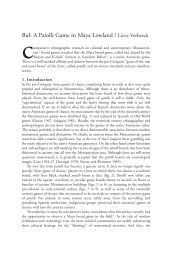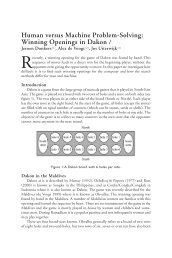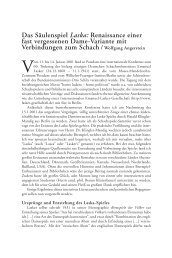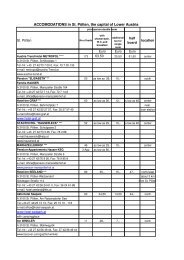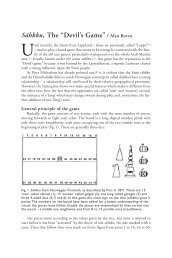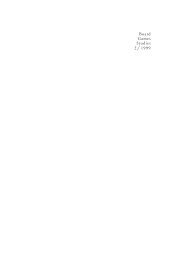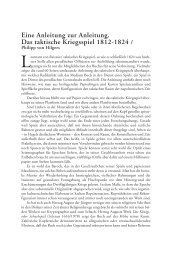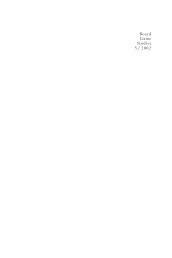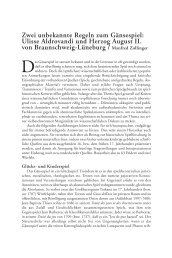“Juden Raus!” (Jews Out!) – History's most - Board Game Studies
“Juden Raus!” (Jews Out!) – History's most - Board Game Studies
“Juden Raus!” (Jews Out!) – History's most - Board Game Studies
Create successful ePaper yourself
Turn your PDF publications into a flip-book with our unique Google optimized e-Paper software.
<strong>“Juden</strong> <strong>Raus</strong>!<strong>”</strong> (<strong>Jews</strong> <strong>Out</strong>!) <strong>–</strong> History’s <strong>most</strong><br />
infamous board game / Andrew Morris-Friedman and<br />
Ulrich Schädler<br />
Twentieth-century proprietary board games have been characterized as being based<br />
on a theme and representing an aspect of real life (Parlett 2000). <strong>Game</strong>s have been<br />
designed that simulate the range of human activities, from hunting and gathering,<br />
to war, business and economics to human relationships. Many such games have as their<br />
theme the teaching of moral values (Goodfellow 1998). “The New <strong>Game</strong> of Virtue<br />
Rewarded and Vice Punished<strong>”</strong> (1820, by Darton) was one of the first mass-produced board<br />
games to reveal moral underpinnings. Other games teach values indirectly through images<br />
used in the game design (Averbakh 1995). Most of these games can be seen within the values<br />
perpetuated by western democracies. But any value system can be incorporated into a<br />
board game and then used to teach whatever the game designer desires.<br />
This paper presents a brief overview of game types that must be considered racist.<br />
One such game from the Nazi period in Germany is described in detail. The game<br />
<strong>“Juden</strong> <strong>Raus</strong>!<strong>”</strong> (<strong>Jews</strong> <strong>Out</strong>!) has as its theme the persecution of the <strong>Jews</strong> in Nazi Germany<br />
and may be the <strong>most</strong> infamous board game in history. (1)<br />
Cultural historians use board game studies to document a society’s changing values<br />
over time since games exemplify the cultural values of the societies that play them<br />
(Whitehill 1999: 116). As a result, the history of racism is reflected in the theme of<br />
many board games. Some of these games use racist images, others make use of racial<br />
themes in the rules of play. Three American games will serve as examples. Two games<br />
from the Milton Bradley Company use racist images of African Americans: “The <strong>Game</strong><br />
of Ten Little Niggers<strong>”</strong> (circa 1895) and “Snake Eyes<strong>”</strong> (circa 1930) (Whitehill 1992: 129).<br />
Both card games have racist illustrations, but racism is not an explicit theme of the game,<br />
and racist attitudes are not directly reflected in the rules (Dennis 1986).<br />
The third example “Gunsmoke<strong>”</strong> (1958, by Lowell) incorporates racist themes in the<br />
rules of play by giving one side an unfair advantage. The game depicts the mythic<br />
American confrontation between “Cowboys and Indians<strong>”</strong> each player representing one<br />
side. The pieces representing Native Americans can be “killed<strong>”</strong> and removed from the<br />
game, while the Cowboy pieces can only be “captured<strong>”</strong> and are always in play. As Polizzi<br />
& Schaefer write: “The odds of winning the game are slightly in favor of the cowboys<strong>”</strong><br />
(Polizzi 1991: 113).<br />
The principal example of racism studied here is <strong>“Juden</strong> <strong>Raus</strong>!<strong>”</strong> (<strong>Jews</strong> <strong>Out</strong>!). It was<br />
published in Germany during the Third Reich period by Günther & Company, Dresden,<br />
and distributed by the firm of Rudolf Fabricius at Bad Neusalza-Spremberg. Two copies<br />
of the game are known to exist. One copy is currently on display at the Museum of<br />
Jewish Heritage in New York City. A second copy of the game is in the collection of the<br />
Institute of Contemporary History and Wiener Library in London. Information about<br />
the game was sent to us by Acting Director Ben Barkow.
48<br />
B OARD G AME S TUDIES 6, 2003<br />
Cultural Background<br />
The persecution of the <strong>Jews</strong> and other minority groups in Nazi Germany began as<br />
political repression, and ended as perhaps the worst genocide in human history. In 1933<br />
Adolf Hitler was appointed chancellor of the so-called Weimarer Republik and the first<br />
concentration camp for political dissidents was established at Dachau. In September<br />
1935 the Nuremberg laws deprived <strong>Jews</strong> of all political rights in Germany, and in<br />
October 1937 Jewish property was confiscated. In 1938 Jewish passports were revoked,<br />
trapping hundreds of thousands of Jewish people within territories controlled by<br />
Germany. In November 1938, a nation-wide pogrom, the “Reichspogromnacht<strong>”</strong>, which<br />
the Nazis called “Reichskristallnacht<strong>”</strong> began against Jewish people. This event, better<br />
known as “Kristallnacht<strong>”</strong> (Crystal Night) refers to the smashing of windows of Jewish<br />
shops and synagogues during these actions carried out by the organizations of the<br />
NSDAP. Soon after, the deportation of tens of thousands of <strong>Jews</strong> to concentration camps<br />
began (Barnavi 1992). It was in this cultural context that <strong>“Juden</strong> <strong>Raus</strong>!<strong>”</strong> was made available<br />
to the public. On December 5, 1938, one month after “Kristallnacht<strong>”</strong> the distribution<br />
firm of Rudolf Fabricius offered a 33.1/3% discount on <strong>“Juden</strong> <strong>Raus</strong>!<strong>”</strong> at the price<br />
of RM 4.50.<br />
Description of the game<br />
<strong>“Juden</strong> <strong>Raus</strong>!<strong>”</strong> is a race game that instills values of a totalitarian fascist regime. It has<br />
both the theme of racial hatred and employs racist images in the game design. The object<br />
of the game is to deprive the German <strong>Jews</strong> of their property and to make them leave the<br />
city. The game board clearly states that the first player to remove six <strong>Jews</strong> from the city<br />
wins the game. In this way the game clearly foreshadows the policy of racial genocide that<br />
was to follow.<br />
Gaming material<br />
The dimensions of the board are 50 x 60 cm, the board is cardboard with cloth<br />
hinges. On the board are 13 specially marked circles with pictures of Jewish storefronts.<br />
On reaching these places a hat representing a Jew is awarded to the player.<br />
The game board has three areas of text. The first sentence says: “Zeige Geschick im<br />
Würfelspiel, damit Du sammelst der Juden viel!<strong>”</strong> (Display skill in the dice game, so that<br />
you collect many <strong>Jews</strong>!). The second reads: “Gelingt es Dir 6 Juden rauszujagen, so bist<br />
Du Sieger ohne zu fragen!<strong>”</strong> (When you succeed in driving out 6 <strong>Jews</strong>, you will be winner<br />
beyond all question!). On the lower portion of the game board can be seen caricatures<br />
of a man, a woman and a child, in the style in which <strong>Jews</strong> were stereotyped at that<br />
time (figure 1). The writing below them reads: “Auf nach Palästina!<strong>”</strong> (Off to Palestine!).<br />
This graphic echoes a description given by Victor Klemperer in his diary (Klemperer<br />
1995: 398). Under March 1st 1938 one reads: “Sie [i.e. the Nazis] haben keinen Sinn<br />
für ihre eigene Komik... Ihre bewußte Komik ist Niedertracht gegen Wehrlose: Hier in<br />
Dresden ist heute ein Faschingsumzug: “Auszug der Kinder Israel<strong>”</strong> (They have no sense<br />
for their own humor... Their deliberate humor is meanness towards the helpless: Today<br />
there is a carnival’s procession here in Dresden: “Exodus of the children of Israel<strong>”</strong>). This
A. MORRIS-FRIEDMAN & U. SCHÄDLER, “JUDEN R AUS!<strong>”</strong> (JEWS O UT!) 49<br />
Fig. 1. <strong>Game</strong> board. (Collection of Institute of Contemporary History and Wiener<br />
Library, London)<br />
Fig. 2. Detail, game pieces as pictured on<br />
the game board.
50<br />
B OARD G AME S TUDIES 6, 2003<br />
“carnival’s procession<strong>”</strong> was typical Nazi cynicism making a joke out of the Exodus story<br />
from the Bible. (2) The fact that the expulsion of the <strong>Jews</strong> has been made a subject of the<br />
procession seems to fit very well into the general theme and graphic imagery of the game<br />
and may have inspired the games anonymous author.<br />
There are two types of game pieces. The “men<strong>”</strong> clearly represent the German Police<br />
and can be identified by the coat and belt drawn on the pieces, as well as the cone like<br />
hat, buttons and boots which appear very similar to the uniforms worn by the German<br />
police at the time (Berenbaum 1993). The pieces are made of painted wood, and measure<br />
5.8 cm x 1.8 cm. (figure 2). The “hats<strong>”</strong> are 3.5 cm in height, 1 cm in diameter and<br />
are made of paper and may have yellowed with age. The faces on the hats are drawings<br />
of grotesque stereotypes of Jewish facial features similar to those drawn on the game<br />
board. One copy of the game has a leather beaker for throwing dice but Mr. Barkow<br />
was uncertain whether this came with the game or was added by the anonymous donor.<br />
<strong>Game</strong> Rules [as translated from the German] (figs. 3 & 4) (3)<br />
“JEWS OUT!<br />
The up-to-date and outstandingly jolly party game for grown-ups and children.<br />
From 2 to 6 players can take part in this extraordinarily amusing and up-to-date<br />
family game.<br />
Equipment: 1 die, 6 figures and 36 little hats. Each player takes one of the figures<br />
numbered 1 to 6.<br />
The method of play is as follows:<br />
Each player rolls the die and places his figure on the start-square of the street whose<br />
number is equivalent to that of the number thrown. Whoever occupies Street One is<br />
the leader and plays first. Each in turn then rolls the die and moves his figure the appropriate<br />
number of spaces towards the central square. If, having crossed the town wall, he<br />
lands on a square marked with a Jewish house, he gets a hat from the game leader and<br />
caps his figure with it. On his next throw he starts moving his figure back towards the<br />
collection-point and hands the hat back in. If a player has thrown a six (for example) and<br />
is now three spaces away from the collection point, he can hand the hat in and then go<br />
forwards three spaces. This coming and going between the town wall and the central<br />
square continues until one player has got six hats over to the collection point. Having<br />
handed in his sixth hat, he then goes back over the numbered squares to the central<br />
square. The first to do this wins First Prize. The other players can either carry on playing<br />
for position, or divide the remaining prizes among themselves according to how<br />
many hats they managed to collect.<br />
Another method of play:<br />
When a figure has been capped, the person playing it continues moving forwards,<br />
according to the number thrown, towards the central square. If he there encounters<br />
another figure with a hat or hats, he can capture its hat or hats and bring them back to<br />
his own collection point. In following this method of play, it is possible for a player who
A. MORRIS-FRIEDMAN & U. SCHÄDLER, “JUDEN R AUS!<strong>”</strong> (JEWS O UT!) 51<br />
Fig. 3. Rulebook cover.<br />
(Collection of Institute of Contemporary History and Wiener Library, London)<br />
Fig. 4. Rules in German.
52<br />
B OARD G AME S TUDIES 6, 2003<br />
is either on his way either to the central square, or coming back from it, to land on several<br />
marked squares, and consequently to collect several hats to bring to the collection<br />
point. When he has handed in six hats, he must go back to the central square. If he is<br />
the first to do this, he wins First Prize.<br />
Published by Günther and Co., D.<strong>”</strong><br />
Possible Origins and Reconstruction<br />
“<strong>Jews</strong> <strong>Out</strong>!<strong>”</strong> is a modified race game with two versions of the rules given. The first<br />
version is a simple game of chance with no interaction between the players. The second<br />
version adds a little more strategy to the game and is similar in feeling to “Parchisi<strong>”</strong> or<br />
“The Hyena <strong>Game</strong><strong>”</strong> (Bell 1979). The main source for the game was certainly “Fang den<br />
Hut<strong>”</strong> (English title “Trap the Cap<strong>”</strong>), a game published by Otto Maier Verlag,<br />
Ravensburg, as early as 1927 and still distributed today in various countries (Glonnegger<br />
1999: 23-24). Two different versions of “Fang den Hut<strong>”</strong> exist, one version is for six players.<br />
The game board uses a graphic of a wagon wheel, with pieces able to move along<br />
squares on the diameter of the circle and also on the spokes running straight from the<br />
outer edge of the circle to the center (figure 5). It was obviously this board that was<br />
adopted by the author of <strong>“Juden</strong> <strong>Raus</strong>!<strong>”</strong>. But the game board lay out, inspired by the<br />
modern design of the Bauhaus, underwent some changes: <strong>“Juden</strong> <strong>Raus</strong>!<strong>”</strong> depicts a<br />
medieval town with an irregular city wall and streets instead of the outer circle and the<br />
straight spokes seen in “Fang den Hut<strong>”</strong>. The black fields of “Fang den Hut<strong>”</strong> where the<br />
caps were captured became Jewish storefronts. A further difference to “Fang den Hut<strong>”</strong>,<br />
where the counters can move around the circle and along the spokes, pieces in <strong>“Juden</strong><br />
Fig. 5. “Fang den Hut<strong>”</strong> (photograph U. Schädler, Swiss Museum of <strong>Game</strong>s).
A. MORRIS-FRIEDMAN & U. SCHÄDLER, “JUDEN R AUS!<strong>”</strong> (JEWS O UT!) 53<br />
Fig. 6. Fabricius promotion flier (photograph U. Schädler).<br />
(Collection of Institute of Contemporary History and Wiener Library, London)<br />
<strong>Raus</strong>!<strong>”</strong> may not move along the city wall but only along the streets. The games are similar<br />
in that both have the red center point as well as the places outside the wheel/city wall<br />
where the captured pieces have to be assembled. Finally the hats especially designed for<br />
the capturing method of “Fang den Hut<strong>”</strong>, are also used to depict the captured <strong>Jews</strong>. This<br />
clearly demonstrates that it was this harmless and successful board game that inspired the<br />
anonymous author of <strong>“Juden</strong> <strong>Raus</strong>!<strong>”</strong>.<br />
<strong>Game</strong> History<br />
The facts concerning the history of the game are few and contradictory. A search of the<br />
state archive of Sachsen at Dresden showed that between 1935 and 1945 there were two<br />
companies with the name Günther & Co., the publisher of <strong>“Juden</strong> <strong>Raus</strong>!<strong>”</strong>. One of them<br />
had been canceled from the registry of trade by 1937. It is not known what type of com-
54<br />
B OARD G AME S TUDIES 6, 2003<br />
Fig. 7. Article in Das Schwarze Korps (photograph U. Schädler).<br />
pany it was, since it is not mentioned in the address books between 1935 and 1938. The<br />
second company is mentioned in the address-book for the first time in 1940. This company<br />
dealt with textiles. The owners were Kommerzienrat Georg Günther and his wife. The<br />
address of the company was Dresden A 16, Gabelsbergerstraße 25, and after 1945<br />
Uhdestraße 33. The company existed until 1950. There is no evidence in the state archive<br />
that either of the two companies published this board game. However, the company<br />
address written on the rule sheet for <strong>“Juden</strong> <strong>Raus</strong>!<strong>”</strong> reads: Günther & Co, Dresden, A 16.<br />
Little information can be gathered about Rudolf Fabricius, the game’s distributor.<br />
From the archive of the city of Bad Neusalza-Spremberg comes the information that<br />
Fabricius (born 1902) was a dealer in food products. Since November 25, 1938 he registered<br />
as “Herstellung, Fabrikation, Vertrieb und Großhandel von und mit Neuheiten<strong>”</strong>.<br />
The flier promoting the game distributed by Fabricius was included in the donation of<br />
the game to the Institute of Contemporary History and Wiener Library. The flier dates<br />
December 5, 1938 and states that the game was now being sold at 33% off its regular<br />
price (figure 6).
A. MORRIS-FRIEDMAN & U. SCHÄDLER, “JUDEN R AUS!<strong>”</strong> (JEWS O UT!) 55<br />
A very different and unexpected opinion is expressed in a review published in the SS<br />
paper Das Schwarze Korps, 52, December 29, 1938, p. 7 (figure 7). The review is full of<br />
anti-Semitic propaganda and is very critical about the game. The unknown author feels<br />
that the game trivializes the anti-Semitic policies favored by the paper and that the international<br />
press will use the game’s existence to make the policies look completely ridiculous.<br />
The author’s main objection is that the game manufacturer is trying to profit from<br />
the Nazi slogan <strong>“Juden</strong> raus<strong>”</strong> (<strong>Jews</strong> out) to promote the sale of the game. The article<br />
translates as follows:<br />
“Jewish problem in the dice cup<br />
In a circular to its customers the company Rudolf Fabricius at Neusalza-Spremberg<br />
i. Sa. [i.e. “in Sachsen<strong>”</strong>, the author] states: Juden raus! has been published in impeccable,<br />
tasteful form and strong style.<br />
There would be nothing wrong with this statement, if it would be a political insight<br />
or a commentary to the measures we have undertaken to fend off the Jewish rabble<br />
of murderers. Yet the declarations of the Fabricius company do not regard the impeccable<br />
form, with which the German people has reacted against the crimes of the<br />
Grünspans and their lot, nor do they regard the strong style of Hermann Göring’s<br />
answer to those crimes.<br />
It is just quite about the supposedly tasteful form and solid design of a ... parlor<br />
game, where tiny little figures of <strong>Jews</strong> are slowly but surely deported to Palestine by<br />
the help of the dice cup. The political slogan “<strong>Jews</strong> <strong>Out</strong><strong>”</strong> is exploited here as a big<br />
seller for all toy shops and trivialized to an amusing pastime for little children!<br />
This invention (DRGM. Nr. 1 446 399!) is al<strong>most</strong> a punishable idea, perfectly suitable<br />
as grist to the mills of hate of the international Jewish journaille, who would<br />
show around such a piece of mischief as a proof for the childish efforts of the nazistic<br />
<strong>Jews</strong>-haters with a diabolic smirk, if it would appear before her crooked nose.<br />
We do not slave ourselves away with the solution of the Jewish question, to relieve<br />
able manufacturers of toys of their worries about a great big seller or to help children<br />
with an amusing little game. We don’t push out the black <strong>Jews</strong>, and how often has<br />
it to be said, to make room for the not less dubious thirst for action of the white<br />
<strong>Jews</strong>. Let this be told to the Fabricius Company, before it dedicates itself to the realization<br />
of its somewhat rash dream to publish its completely unwelcome big seller for<br />
Großdeutschland at the forthcoming fairs in spring!<br />
<strong>Jews</strong> out! yes of course, but also rapidly out of the toy-boxes of our children, before<br />
they are led into the dreadful error that political problems are solved with the dice<br />
cup.<strong>”</strong><br />
The public reaction to the game can not be assessed but circumstantial evidence<br />
indicates that the game sold very poorly. The game is mentioned by Barbara Rogasky,<br />
who writes (without giving further sources) that the game was widely distributed and<br />
that by 1938, when the politics of the Nazis still aimed at the forced emigration of the<br />
<strong>Jews</strong>, this game had sold over 1 million copies (Rogasky 1999: 41). But the information
56<br />
B OARD G AME S TUDIES 6, 2003<br />
from the Fabricius’ advertisement as well as the article in Das Schwarze Korps contradicts<br />
her statement: the game was published very late in 1938 and was to be promoted only<br />
in 1939. It is <strong>most</strong> likely therefore that Rogasky was mislead by the company advertisement,<br />
which tried to promote a “big seller<strong>”</strong> right from the beginning. It seems very<br />
unlikely that the game could have been successful in the face of condemnation by the<br />
SS and the resulting threats to Rudolf Fabricius.<br />
The state archive at Leipzig, where the documents concerning the fairs at Leipzig<br />
are preserved, confirmed by letter that the Fabricius company was not present at the toy<br />
fair in 1939 nor was the game promoted there, despite the company’s previous<br />
announcement. Unfortunately no information was available concerning Fabricius’ presence<br />
at the fair at Vienna in 1939.<br />
Rumors<br />
<strong>“Juden</strong> <strong>Raus</strong>!<strong>”</strong> has been known to a handful of scholars for many years. It has been<br />
used as evidence by museums and college courses on the holocaust of the extent of anti-<br />
Semitism in Nazi Germany. In the course of our research many scholars replied that<br />
they had “heard<strong>”</strong> or “thought they saw somewhere<strong>”</strong> information about the game that,<br />
although interesting, cannot be substantiated. As is the case with many games, a mythology<br />
of rumors has developed around <strong>“Juden</strong> <strong>Raus</strong>!<strong>”</strong>. One rumor has it that the two existing<br />
copies were prototypes and that the game was never published, while a contradicting<br />
rumor states that <strong>“Juden</strong> <strong>Raus</strong>!<strong>”</strong> was manufactured but was so unpopular that it was<br />
given away for free. Another rumor claims a third copy of the game was recently sold to<br />
a private collector through internet auction. There is even some talk of a different (and<br />
more blatant) anti-Semitic game of the period described as a “death camp version of<br />
parchisi<strong>”</strong> where the goal of the game is to be the first to deliver <strong>Jews</strong> a position on the<br />
game board which symbolized the place of their murder. Several people have claimed to<br />
have heard of this game, but no version is known to exist. Anyone with information<br />
about the rumors mentioned above are asked to contact the authors.<br />
Comments<br />
<strong>“Juden</strong> <strong>Raus</strong>!<strong>”</strong> is not a “Nazi board game<strong>”</strong> as it is sometimes called. There is no Nazi<br />
symbolism used in the game design and the article published in Das Schwarze Korps<br />
shows that the game was disdained <strong>–</strong> at least officially <strong>–</strong> in a major publication of the<br />
<strong>most</strong> important Nazi organization. But its true history may never be known for certain<br />
and many unsubstantiated rumors about the game exist.<br />
What insights are achieved from <strong>“Juden</strong> <strong>Raus</strong>!<strong>”</strong> about Nazi culture? It is hard to<br />
imagine a family sitting at a table playing a game that taught racial hatred. Yet it seems<br />
there were people like Rudolf Fabricius who imagined that some families would do just<br />
that. Fabricius was one of those mere supporters who thought to make some profit by<br />
following in the wake of Nazi anti-Semitic propaganda. Today <strong>most</strong> people react with<br />
disbelief or disgust when informed of the game’s existence. <strong>“Juden</strong> <strong>Raus</strong>!<strong>”</strong> shows that<br />
after decades of propaganda, anti-Semitism was so deeply rooted in German society in<br />
the 1930s, that someone thought it would be a good subject for a children’s game.
A. MORRIS-FRIEDMAN & U. SCHÄDLER, “JUDEN R AUS!<strong>”</strong> (JEWS O UT!) 57<br />
Racism is present in many board games, but <strong>“Juden</strong> <strong>Raus</strong>!<strong>”</strong> is unique in its portrayal of<br />
how racism manifests itself in society and is a terrifying example of the banality of evil.<br />
However, this game’s message of hatred still resonates today. If it were renamed<br />
“Muslim Serbs <strong>Out</strong>!<strong>”</strong> or “Rwandan Tutsis <strong>Out</strong>!<strong>”</strong> this timeless theme of racial hatred<br />
could easily be updated. There are many areas of the world where such a game might still<br />
find a receptive audience. <strong>“Juden</strong> <strong>Raus</strong>!<strong>”</strong> reminds us that the events of this terrible period<br />
in world history are not confined to the past. Viewed in this light the game becomes<br />
more then just a distasteful footnote to the history of board games. <strong>“Juden</strong> <strong>Raus</strong>!<strong>”</strong> is a<br />
warning to us all.<br />
Bibliography<br />
Averbakh, Yuri L. 1995. <strong>Board</strong> games and Real Events. In: de Voogt, A.J., ed., New<br />
approaches to board games research: Asian origins and future perspectives, Leiden: 17-23.<br />
Barnavi, Eli. 1992. A Historical Atlas of the Jewish People. New York.<br />
Bell, Robert C. 1979. <strong>Board</strong> and Table <strong>Game</strong>s from Many Civilization. Revised Ed. New<br />
York.<br />
Berenbaum, Michael. 1993. The World Must Know: The History of the Holocaust....<br />
Boston.<br />
Dennis, Lee. 1986. Warman’s Antique American <strong>Game</strong>s 1840-1940. Elkins Park, PA.<br />
Glonnegger, E. 1999. Das Spiele-Buch, Uehlfeld.<br />
Goodfellow, Caroline. 1991. A Collector’s Guide To <strong>Game</strong>s and Puzzles. London.<br />
Goodfellow, Caroline G. 1998. The Development of the English <strong>Board</strong> <strong>Game</strong> 1770-<br />
1850. In: <strong>Board</strong> <strong>Game</strong>s <strong>Studies</strong> 1: 70-80.<br />
Klemperer, Viktor. 1995. Ich will Zeugnis ablegen bis zum letzten. Tagebücher 1933-1941.<br />
Berlin.<br />
Parlett, David. 1999. The Oxford History of <strong>Board</strong> <strong>Game</strong>s. Oxford.<br />
Polizzi, Rick and Schaefer, Fred. 1991. Spin Again: <strong>Board</strong> <strong>Game</strong>s from the Fifties and<br />
Sixties. San Francisco.<br />
Reurich, Lucien. 1995. Towards a Philosophical Characterization of Playing <strong>Game</strong>s. In:<br />
de Voogt, A.J., ed., New approaches to board games research: Asian origins and future<br />
perspectives, Leiden: 185-189.<br />
Rogasky, B. 1988. Smoke and Ashes. The Story of the Holocaust, New York.<br />
Rogasky, B. 1999. Der Holocaust. Ein Buch für junge Leser, Berlin.<br />
Whitehill, B. 1992. <strong>Game</strong>s: American Boxed <strong>Game</strong>s and their Makers 1822-1992, Radnor.<br />
Whitehill, B.1999. American <strong>Game</strong>s: a historical perspective, <strong>Board</strong> <strong>Game</strong>s <strong>Studies</strong> 2,<br />
116-141.
58<br />
B OARD G AME S TUDIES 6, 2003<br />
Notes<br />
1. Special thanks to: David Parlett, Dr. Irving Finkel at the British Museum, Ben Barkow and<br />
Rosemarie Nief at the Institute of Contemporary History and Wiener Library, Mr. Paulik and<br />
Mr. Wagner at Bad Neuensalza-Spremberg, Dr. Stephen Feinstein, Center for Holocaust and<br />
Genocide <strong>Studies</strong>, University of Minnesota.<br />
2. It is important to note that as the procession commenced the on lookers were encouraged by<br />
the organizers to shout <strong>“Juden</strong> <strong>Raus</strong>!<strong>”</strong> at the Jewish participants.<br />
3. We are indebted to David Parlett for the translation from German to English.



